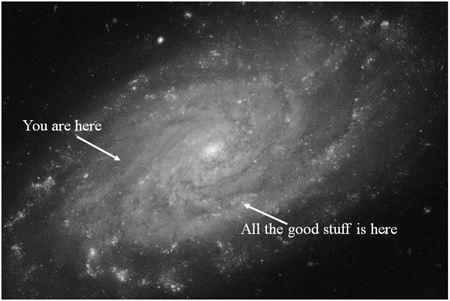
INTRODUCTION
What’s out there? The answer to that question involves some practical issues. Are we alone or is there someone else to whom we might one day be able to say hello? What will we do to ensure the survival of the human race if a large asteroid comes our way? Is there enough room on this planet for all of us and for the millions more who continue to arrive regularly?

Some of us humans aren’t content to stay in one place very long. There’s something about a crowded environment that makes us restless. We want to move on, to see new things, to have more space and to go places, to paraphrase Captain Kirk, where nobody’s already hanging out. The problem is that we’ve just about filled all the available locations on Earth.
Some of us are satisfied living our lives using essentially the same zip code we were born into. We may never really care to look above the rooftops. But many of us are curious about what’s out beyond the next village. About what’s over the horizon. We want to know if there are others like us, peering out at the stars with their telescopes, also wondering if they are alone. Someone with whom we might sit down and enjoy a pizza and trade notions about how the universe works. And maybe one day reminisce about visits to distant stars and worlds that light up at night.
Another concern is that our existence as a species might be short-lived unless we provide some insurance for ourselves. Unless we do something to spread our seed beyond the world that gave us birth. The fossil record is full of species that were at one time masters of the planet. Our existence is but a small part of the planet’s history and that history has not been kind to many of its previous inhabitants. How might we go extinct?
Seriously? There are a number of possibilities. Supernova fallout is one. All we’d need is the collapse of an unstable star in the general neighborhood to bathe us in radiation. (It’s even possible such a collapse has already happened, but the light and the shock wave just haven’t gotten here yet.) Or a brown dwarf could drift into the system and collide with the Sun. Lights would go out and real estate values in Florida would plunge. We might do the damage ourselves by waging nuclear war. And we’re well on our way to overpopulating the planet.
We therefore have a strong argument for moving some of us into space and out of the immediate danger zone. Looking at history, and at what’s going on in the world today, we know that the course of events is utterly unpredictable and potentially lethal. Where, then, do we go? And how do we get there?
There’s no place within the solar system that would allow the existence of a self-sustaining colony. So we have to look beyond its limits.
We’ve asked a diverse set of science fiction authors to speculate on what an interstellar voyage based on real physics might actually look like. We also asked some scientists and engineers who think about such things as interstellar travel to weigh in on how it might be accomplished. You hold the result in your hands: an anthology of adventures replete with danger, ingenuity, hope, love and loss, with a surprise or two thrown in. And a few essays describing exotic strategies that might one day allow us to reach the stars. Beware: One of our guidelines for both the fiction and the non-fiction is that any method of traveling to the stars has to be based on what we currently know about how the universe works. You won’t find faster-than-light drives, hyperjumps or star gates within these pages.
For those interested in interstellar travel and wondering what they can do to help make it happen we highly recommend you find a way to get involved with the Tau Zero Foundation. Please check out their website for more information: http://www.tauzero.aero/
Ad Astra!
—Les Johnson and Jack McDevitt